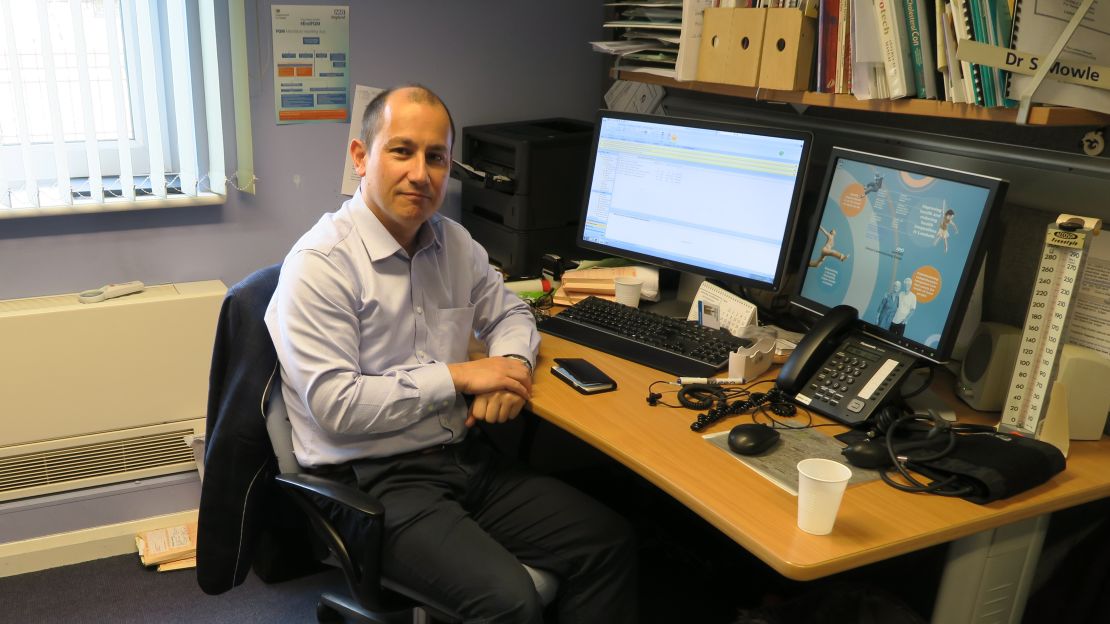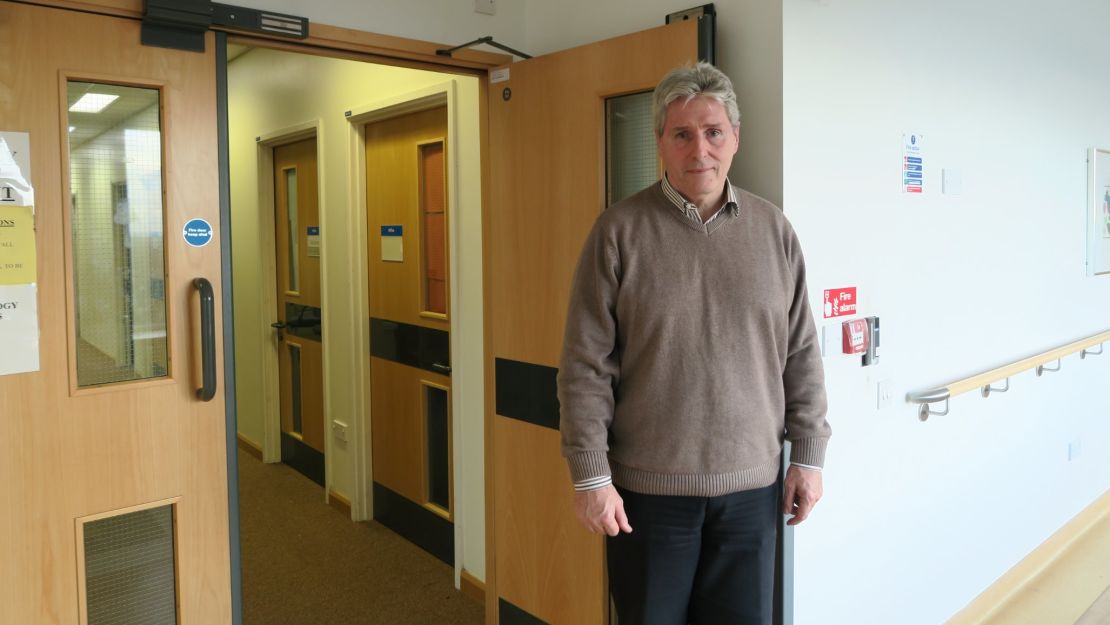Story highlights
The UK's National Health Service was formed in the 1940s to provide universal health care
Today, the service is under severe financial strain
In a doctor’s waiting room in South London sit three people of varying ages and ethnicities, waiting among a sea of empty green plastic chairs.
It’s Tuesday afternoon in the Hetherington Group Practice, which serves more than 8,500 people from dozens of miles in every direction from its base in the bustling area of Brixton.
Adorning the many notice boards on the walls are posters asking people to get flu vaccinations, to embrace more walking as part of their day to day and to speak up if they feel that they may have symptoms of bowel cancer.
Another poster informs that the Accident and Emergency room at the local hospital “won’t kiss it better,” appealing to people not to visit their local ER when something is not urgent.
Records from the National Health Service show that the numbers of people visiting an emergency room in England have risen from just over 4.5 million per quarter in 2004 to almost 6 million per quarter by the end of 2017 – almost a 25% increase.

In the corner of the waiting room sits a “patient pod” consisting of a computer, a blood pressure machine and scale, for people to measure their vitals in their own time.
They can even monitor their mood by answering a series of questions about how they’re feeling and what they’re thinking. The practice has more than 230 patients registered with severe mental health problems, such as psychosis.
“It’s about managing demand,” said Dr. Steve Mowle, one of the nine physicians at the practice and a spokesman for the Royal College of General Practitioners.
This “pod” and the option of a phone consultation aren’t the norm for all general practitioners’ facilities but Mowle – like any other GP in the United Kingdom – has a budget to spend on his practice each year, based on a capitation, an amount paid from the government’s budget per patient registered. He and his partners may use it how best they see fit to meet the multiple needs of their large patient base.
Demand on the practice has increased significantly in recent years.
Unusually, the rise is not in terms of patient numbers, which have in fact fallen, but by people living longer with greater numbers of increasingly complex conditions to manage. Each day, Mowle will have contact with 40 to 50 patients, he explained, with 60% of those in person and the rest through phone consultations.
“My clinics are longer,” Mowle said. A clinic represents a half-day of seeing patients and is meant to last three hours each. His clinics routinely last at least five hours.

“Being a full-time GP is impossible,” he said, adding that there is “more and more administration” on top of seeing patients.
The demographic of his patient base is as vast as the region the practice covers, ranging from the homeless, newly arrived refugees and blue-collar workers to high-earning middle-class and lawyers and bankers whose houses are worth millions. More than 140 languages are spoken locally.
Despite their differences, the patients at this clinic – and anywhere else in the UK – have one thing in common: Not one of them will pay or receive a bill for the care they receive here.
Their health care is free and universal and has been since the formation of the country’s National Health Service in 1948.
The population’s health care is funded through tax and compulsory national insurance contributions deducted from income, which go toward many state benefits.
But as the demand for health care has increased across all levels of care – primary, secondary and tertiary – so has the strain on this once-coveted health system – particularly on its finances.
A changing climate for health care
Health care budgets in the UK have been plateauing, with only minor increases in spending, as percentages of gross domestic product spent on it have been declining.
According to the Kings Fund, an independent health care charity, the National Health Service is halfway through its most austere decade ever. Figures from the World Bank reflect this: In 2009, the UK spent 9.8% of its GDP on health care; by 2014, it fell to 9.1%, according to the World Bank.
Along with this came more people, who are living longer and with multiple conditions like diabetes and heart disease that require treatments also rising in cost. Meanwhile, hospital bed numbers have fallen, numbers visiting emergency rooms have risen, and the demand for social care – such as home care or equipment – in the community has increased with limited services in place to provide it, again leaving more people with fewer hospital beds.
“The current situation is unsustainable,” said Dr. Ian Eardley, vice president of the Royal College of Surgeons in the UK and practicing surgeon at a hospital in Leeds. “There are patients who are medically fit but can’t get help in the community, or support, to leave hospital.”
Austerity has brought extended wait times for people seeking elective or routine treatments, such as knee or hip surgery, while emergency treatments for serious issues such as cancer or heart attacks continue to be treated promptly, as they should, according to Mowle.
Guidance requires anyone in the UK with signs of cancer be seen within two weeks.
“(But) you can’t bring patients in for elective surgeries,” said Eardley, who further stressed the complexities surrounding people living longer.
“People often live longer with other medical problems being controlled and managed,” he said, adding that greater expectations by patients today and the tendency to discuss cases in greater detail all add time and strain to an already overwhelmed system.
Another financial constraint is the increasing, but important, role of computing.
“Most of these countries have seen a need for increased spending with changing technology,” said Martin McKee, professor of European public health at the London School of Hygiene and Tropical Medicine.
Real National Health Service spending in 2015-16 increased by just 1.6%, according to the Kings Fund.
“The budget has been frozen for too long,” McKee said.
More funding is needed, he said, to decrease the debt owed by hospitals whose budgets were not enough and to ensure a greater transition from care settings into the community.
Is more spending better for health care?
The UK spring budget for 2017 announced last week pledged £2 billion ($2.5 billion) toward adult social care over the next three years to “ease pressure on the NHS.”
£425 million ($525 million) was also announced to be invested in the NHS in the next three years, with £100 million ($125 million) going to Accident and Emergency departments in 2017-18, to help them manage increasing demand.
Experts like McKee and Eardley welcome the investment, but believe it will not be enough.
“The UK is not exceptional,” McKee said, adding that other countries have similar levels of health care coverage using a tax-based system, including Finland, Sweden, Portugal and Spain. “The broad model of tax-based funding is common in quite a few countries.”
A recent report from the Organisation for Economic Co-operation and Development (PDF) highlighted that, although access to care in the UK is good, the quality of care is uneven and continues to lag behind that of many other countries.
McKee also highlighted Germany and France, which spent 11.3% and 11.5% of their GDPs on health care, respectively, in 2014 and have more beds per capita, more doctors per 1,000 people and longer life expectancies.
Germany and France use a social insurance model to pay for their health care: Deductions are taken from income, but unlike in the US, everyone is covered, and companies don’t make a profit. Those contributing also “own” the organizations involved through boards and unions, McKee said.
People pay a fee at the point of care, though it’s just $5 to $11 in Germany and $25 in France, which is often reimbursed.
The Western country spending the most on its health care is the US, which spent 17.1% of its GDP on health care in 2014.
Yet a series of factors – such as a lower life expectancy and uneven coverage – highlight that increased expenditure alone is not always a good thing. A system to manage it best is key.
“The US is an outlier internationally,” McKee said. “No one would say the US (model) is good … for the population.”
Treatments and new technologies for conditions such as cancer often lead from the US, but the key issues are access and the varying amounts that could be charged as a fee to provide them.
McKee added that the private insurance-based model in the US, covering only those who are insured, leads to companies in the industry working toward profit. “This leads to more division and less universal coverage,” he said.
“If you have lots of money, you get good care,” Eardley said about US health care. “If you don’t have money, you don’t fit into the system,” he added, calling such a system “wasteful.”
Experts in the UK are eager to stress the cost-efficiency of the National Health Service. According to the Royal College of General Practitioners, the UK pays the least per patient than most countries in the West.
In comparison with the US, Europe’s universal coverage, with tax- and social-fund-based financing through contributions, spends less and has more care that’s better, according to McKee.
Many countries on the continent still have a small sector of patients using private insurance. In the UK, an estimated 11% of the population has private insurance, often through their employers. In Germany, top earners can opt out of the public system and pay privately instead, representing an estimated 10% of Germans.
At the core of the debate around health care, money alone is not the issue; it’s the model of care.
What is health care?
“Health care should be free at the point of delivery,” said Dr. Richard Kerr, a council member of the Royal College of Surgeons in the UK and consultant neurosurgeon at a large regional hospital in Oxford. “There is a fee structure behind it, but when a patient comes to see me … the issue of money never comes into it.”
Kerr believes countries worldwide can learn from those on mainland Europe, such as Germany and France, where the population receives great care, in his opinion, with good quality but pays more for it through taxes. “They are taxed higher but have much more investigative health care,” Kerr said.
“We should look at the different models of health care and take the good aspects of it … without getting rid of the basics of what we’ve got,” he added. “But what you get for your buck is more here.”
With the UK being more cost-efficient, he ponders whether that is something to be proud of. “If you receive the same level of care with less money,” that is indeed a point of pride. But with patient waiting times up to 20 weeks in some cases, he added, that is not the case.
The neuroscience department at his hospital in Oxford is the regional hospital, a point of tertiary care where patients requiring specialist procedures are referred from their district hospitals. It serves more than 2.8 million people across a 100-mile radius, said Kerr, with just 60 beds in his main ward and another 13 in the intensive care unit.
The building is just a decade old, light and airy in design, but as he walks through the wards, he highlights the shuffling he and his team do on a regular basis between main wards and the ICU to ensure that all patients can access a bed and undergo their procedures.
Related content: How Obamacare stacks up against global health systems
Staffers borrow beds between the departments, he explains, so spare beds in the ICU will sometimes be used for his less severe cases. But he shows further frustration with the lack of social care resources for patients away from his hospital, such as the provision of home carers or equipment to keep them mobile, or changes to make their homes more accessible or to help them access day centers. These are crucial, he believes, particularly as the population continues to live longer.

Between 2014 to 2015, 72% of more than 1.8 million new requests for social care support requested from councils in England were clients aged 65 and over, according to NHS data.
In addition to keeping beds unnecessarily occupied, resulting in a “domino effect,” he explains that “if a patient has social care needs, a busy environment (like a hospital) isn’t the best place for them,” he said.
Neurosurgical procedures vary also greatly, with some patients needing just 24 hours to recover while others have stayed as long as 100 days.
“We have to cancel patients at short notice sometimes,” he said, not only leaving patients untreated but leaving surgeons unable to do their jobs.
During this visit, Kerr is smiling, as for once, he has some beds going spare on his wards. He is ready for whatever comes his way. This is not the norm, he said.
“There is pressure on us now, but this is not new,” he said of demands on the wards and his outpatient clinics. “My clinic overruns. It always does … so there’s frustration there.”
But Kerr wants to carry these realities forward and kick-start a debate to get the UK government investing more for even greater efficiency, enabling greater capacity to deliver care.
“When I’m old and crumbly, I don’t want to have to wait,” he said, thinking of his patients. He and others in the field want reform or restructuring to get people discussing what health care is, as its meaning has changed dramatically since the National Health Service’s inception.
“We need a commission,” he said, stating a need to push for patients, cross-party politicians, policymakers and medical practitioners to come together to define health care.
Mowle agreed, adding that the separation of “health care” and “social care” is no longer acceptable and is what has led to the fragmentation of services in the UK.
Join the conversation
“We need a debate asking, what do you want out of health care?” Kerr said. “Do you want to continue treating everything? Yes, you do, but we can’t do it under the current financial envelope.”
Currently within the health service, certain conditions are not covered – such as more cosmetic procedures – leaving some patients unsatisfied.
The need to identify what people on each side of the debate believe health care to be, and which aspects they prioritize, will help manage expectations as well as resources, Kerr explains, not only in the UK, but also more globally.
He believes this will lead to a happier and more satisfied patient base, particularly among those left behind – either waiting in the UK or uninsured in the US. But it won’t be easy.
“Health care is incredibly complex. … The growing number of older people with multi-morbidities are having very very complex trajectories through the health and social care system,” McKee said. “We shouldn’t underestimate the challenges.”




